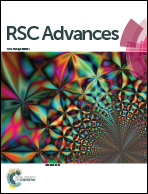Hedgehog-like hierarchical ZnO needle-clusters with superior electron transfer kinetics for dye-sensitized solar cells†
Abstract
Hedgehog-like hierarchical ZnO needle-clusters, three-dimensional (3-D) ZnO flowers and one-dimensional (1-D) ZnO needles have been synthesised via a facile hydrothermal method. These samples with different morphologies and microstructures were used to fabricate photoelectrodes for dye-sensitized solar cells (DSSCs). Out of the three samples, current–voltage (I–V) curve measurements show that DSSCs with hedgehog-like ZnO needle-clusters display the best photoelectrochemical performance which can be attributed to enhanced light harvesting and faster reaction kinetics resulting from the unique morphology. The UV-vis absorption and diffused reflectance spectra indicate that hedgehog-like ZnO needle-clusters show higher light harvesting abilities due to high UV absorption, stronger light scattering, as well as a high surface area. Electrochemical impedance spectroscopy (EIS), intensity-modulated photocurrent spectroscopy (IMPS), and intensity-modulated voltage spectroscopy (IMVS) further demonstrate that hedgehog-like ZnO needle-clusters provide superior electron transfer kinetics: fast electron transfer and long electron lifetimes with suppressed recombination. The ZnO needle-clusters obtained not only provide a 3-D matrix but also avoid extensive grain boundary formation. The discoveries from this work are important for the design of efficient photoanode materials with optimum structures for DSSCs.


 Please wait while we load your content...
Please wait while we load your content...